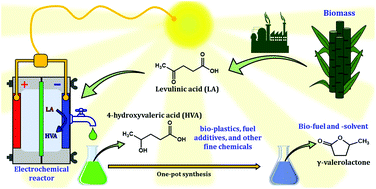Tuning the selectivity of electrochemical levulinic acid reduction to 4-hydroxyvaleric acid: a monomer for biocompatible and biodegradable plastics†
Abstract
Levulinic acid (LA) is a biomass-derived feedstock that can be converted to a wide array of value-added products; several of these can be accessed efficiently by electrochemical conversion. Herein, we present a study of factors governing LA conversion in electrochemical environments. Most notably, we identify an unprecedentedly efficient pathway forming 4-hydroxyvaleric acid (HVA), a valuable monomer that can be used for production of bio-polyesters—specifically, poly(hydroxy acids)—as well as γ-valerolactone (GVL) (a green fuel/solvent) and other fine chemicals. This method shows >99.9% selectivity and >80% faradaic efficiency for conversion above 80%. Production rates higher than 40 g L−1 h−1 (or 200 kg L−1 mgeom.−2 h−1) were achieved; these are substantially higher than reports for compatible biochemical methods. We further identify mechanistic insights regarding the steering of selectivity toward this new pathway in comparison to known electrochemical routes toward valeric acid (VA) or to GVL. Finally, we provide a fast, sequential one-pot synthesis route to transform electrochemically-produced HVA to GVL with higher overall selectivity and faradaic efficiency than can be achieved by direct aqueous electrochemical conversion of LA to GVL (96% conversion and >99.9% selectivity, giving a total yield of 93% from LA).



 Please wait while we load your content...
Please wait while we load your content...
